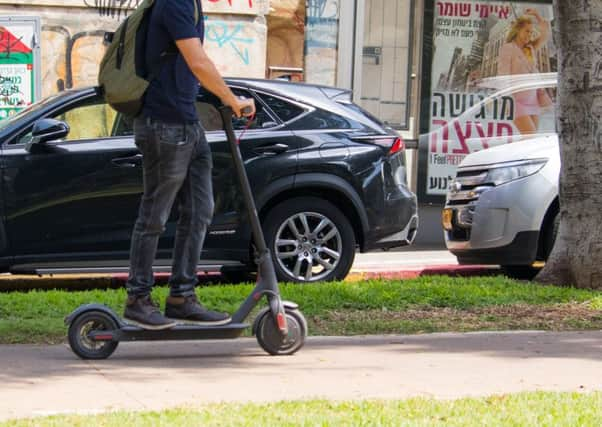Why Scotland’s roads aren’t ready for electric scooters – Alastair Dalton


They offer a potentially attractive new way of getting about – but also threaten chaos on Scotland’s car-centric road networks.
Electric scooters are commonplace in some European countries and US states, and the UK Government is now considering whether to allow them here too.
Advertisement
Hide AdAdvertisement
Hide AdMinisters announced this week they will “consider options for appropriate testing regimes to ensure any such vehicles on the road are safe and fit for purpose”, which could be followed by localised trials.
On the face of it, being able to hop on and effortlessly zip about our towns and cities has obvious appeal – especially to non-cyclists.
It is hardly “active travel”, like walking and cycling, but could encourage some to switch from cars or taxis on short journeys.
Anything electrically powered, which has no emissions on the street, also has to be a positive as part of efforts to cut urban air pollution.
Advertisement
Hide AdAdvertisement
Hide AdHowever, letting loose a new form of transport on roads still woefully unsuited for cycles could just make things worse for everyone.
That’s not to say there’s not a case for them – but the radical redrawing of road space away from the car should be accelerated first.
The brave would take their chances scooting among other traffic, though many are likely to be deterred from sharing roads with lorries, buses and taxis, let alone the cars who already pass cyclists intimidatingly close.
There’s also the small matter of scooters’ 8in wheels not being pothole friendly, causing discomfort if not danger, as shared transport group Comouk has highlighted.
Advertisement
Hide AdAdvertisement
Hide AdMost who scoot are likely to want to stick to the relative safety of pavements and cycle lanes – if that is permitted. But here, a different risk is created, of scooters colliding with pedestrians.
There are far too few cycle lanes they could use, on roads or pavements, and even fewer segregated lanes, albeit cities like Glasgow are adding more.
In addition, there is already potential conflict between walkers and cyclists on shared paths, some of which would struggle to cope with more riders, let alone scooters too.
Another concern is street clutter. Recent visitors to Berlin and Brussels tell me of large numbers of scooters strewn across pavements.
Advertisement
Hide AdAdvertisement
Hide AdTechnology may now enable scooters to be left “dockless”, but this has caused a big problem in places like San Diego.
It’s bad enough trying to negotiate pavements already littered with advertising A-boards, so this could cause another hazard.
Karen Millhouse, a resident of the Californian city, emailed me this week: “I think we have more than 25,000 dockless scooters in our fair city, and they just keep coming. It is a nightmare, especially for pedestrians and the disabled.”
She said Disability Rights California had even filed a class action against scooters blocking pavements.
Advertisement
Hide AdAdvertisement
Hide AdA better plan for Scotland – and the UK – would be to focus on electric bikes first. The main rental schemes in Edinburgh and Glasgow are due to add them later this year, along with other parts of Scotland such as Stirling.
Electric bikes are equally effortless to ride, but unlike scooters provide nearly as much exercise as traditional cycling, so have much more to commend them.
They also encourage people to cycle further, and have a similar top (power-assisted) speed – 15mph – as has been proposed for scooters.